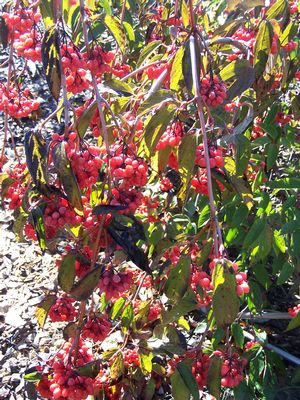View All Plants :: View All DECIDUOUS SHRUBS
Viburnum setigerum
Tea Viburnum
Plant Type:
DECIDUOUS SHRUBSViburnum setigerum – White May flowers lead to late season oval fruit clusters that transform from glossy light orange then deepen and darken to scarlet-red. Attractive somewhat weeping foliage sometimes turns red-purple in autumn. One year the leaves turned black, an unexpected and stunning surprise – with the copious scarlet fruit it smacked of Halloween! The Tea Viburnum is either self-fruitful or is crossing annually with another viburnum on the property for its fruit set is consistent, opulent and so heavy that the stems weep under the weight. We like this plant a lot. Oh, heck – we like all the viburnums a lot! For more information about the Tea Viburnum please see our Viburnum setigerum: The Tea Viburnum article in HERALD.
From Leonard E. (PA) on 9.10.2014
Hi Wayne,
My tea viburnum just arrived and it's a beautiful plant! I didn't expect such a nice one, mail ordered. Thank you!
Len
Characteristics and Attributes for Viburnum setigerum
Season of Interest (Flowering)
- Spring
Season of Interest (Foliage)
- Spring / Summer / Autumn
Autumn Interest
- Fruit / Berries / Seed Heads
- Autumn Leaf Color
Nature Attraction
- Songbirds
- Honey Bees & Native Bees
- Deer Resistant
Light
- Full Sun
- Mostly Sunny
Attributes
- Specimen
- Shrub Border
- Hedge
- Wildlife Garden
- Hedgerow
- Natural Garden
Growth Rate in the Garden
- Moderately Fast
Soil
- Fertile
Origins
- China
Propagated By
- Cutting Grown
Genus Overview: Viburnum
Common Name: Viburnum
Viburnum. This genus is full of fantastic, multi-season garden worthy shrubs. Garden heroes. Spring flowers, often large and showy, many with heady sweet fragrance are arranged in cymes. Some smell of musk (Viburnum dilatatum) while others produce no fragrance at all. Flowers are followed with berries. If late season and autumn berries are desired then planting two of a species will ensure fruit set; for instance, Viburnum dilatatum 'Erie' and V. dilatatum 'Michael Dodge' will pollinate each other and produce fruit. Viburnum cassinoides is closely allied with V. nudum; but if the flowering times do not overlap then there will be no fruit. However, if you plant V. nudum 'Winterthur' in proximity with V. nudum var. angustifolium, 'Longwood', 'Moonshine' or 'Pink Beauty' berries will abound. Another interesting example is V. lantana which crosses with V. burejaeticum and vice versa. Any V. plicatum f. tomentosum selection such as 'Shasta' or 'Shoshoni' will pollinate with all other V. plicatum f. tomentosum selections like 'Copper Ridges or 'Pink Beauty'. But if you were to plant two 'Shasta' side by side with no other V. plicatum f. tomentosum in near proximity then your effort will be fruitless. As with almost all in the universe of plants there are exceptions. There is one viburnum which appears to be self-fruitful, Viburnum setigerum the Tea Viburnum. Another interesting exception to the rule is Viburnum nudum 'Pink Beauty' which is also self-fruitful - a departure from its siblings. And on the other spectrum are two I can think of off-hand that are barren, Viburnum plicatum 'Roseum' and Viburnum plicatum 'Kern's Pink'. Oftentimes, the dwarf viburnums reamin in a juvenile state and do not produce fruit. All Viburnum of any size that do produce fruit are magnificent in the late season garden. And they feed all manner of birds. Larger, denser shrubs provide cover and nesting opportunities. Nearly all Viburnum have terrific autumn foliage colors, too. Viburnums are members of Caprifoliaceae. All prefer part to full sun and fertile soils. All are cutting grown. Many thanks to Gary Ladman of Classic Viburnums who generously set us straight regarding some of the details we had originally incorrectly lauded... ya can't know everything!


